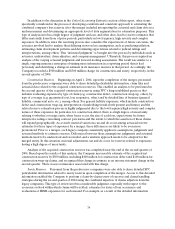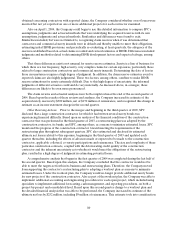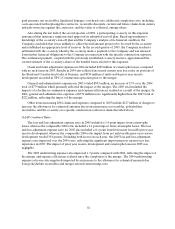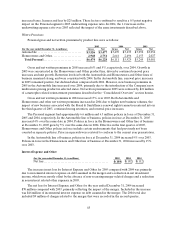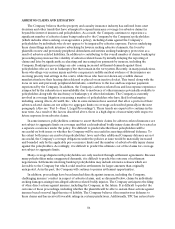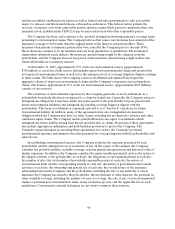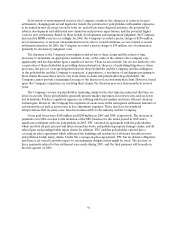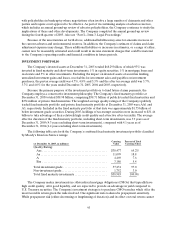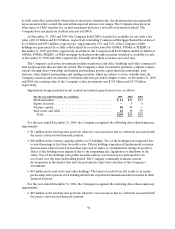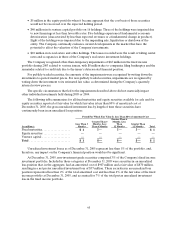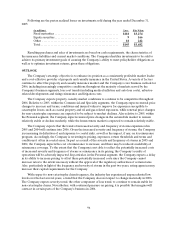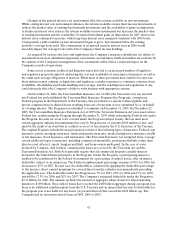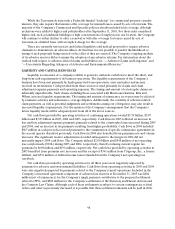Travelers 2005 Annual Report Download - page 100
Download and view the complete annual report
Please find page 100 of the 2005 Travelers annual report below. You can navigate through the pages in the report by either clicking on the pages listed below, or by using the keyword search tool below to find specific information within the annual report.
88
The Company categorizes its asbestos reserves as follows:
Number of
Policyholders Total Net Paid
Net Asbestos
Reserves
(at and for the year ended December 31,$ in millions) 2005 2004 2005 2004 2005 2004
Policyholders with settlement agreements .......... 28 29 $ 1 69 $67
$1,357
$1,431
Home office, field office and other................ 1,748 1,921 172 210 2,483 1,975
Assumed reinsurance andInternational ............ —
—
58 24
524 526
Total ........................................ 1,776 1,950 $ 3 99 $301
$4,364
$3,932
The policyholders with settlement agreements category includes structured agreements, coverage in
place arrangements and, with respect to TPC, Wellington accounts and the settlement of the Statutory and
Hawaii Actions and the Common Law Claims (for a fuller description of these matters, see “Item 3—Legal
Proceedings”) (collectively the “Direct Action Settlement”). Reserves are based on the expected payout
for each policyholder under the applicable agreement. Structured agreements are arrangements under
which policyholders and/or plaintiffs agree to fixed financial amounts to be paid at scheduled times.
Structured agreements include the Company’s obligations related to PPG Industries, Inc. (PPG). In
May 2002 the Company agreed along with approximately three dozen other insurers and PPG on key terms
to settle asbestos related coverage litigation under insurance policies issued to PPG. This settlement is to
be incorporated into the Plan of Reorganization (the Plan) proposed as part of the Pittsburgh Corning
(PC) bankruptcy proceeding. There remain a number of contingencies to consummation of the settlement
including the final execution of documents, court approval of the PC Plan over pending objections,
approval of the settlement and possible appeals. Pursuant to the proposed PC Plan, PC along with
enumerated affiliated companies (including PPG and Corning) are to receive the protections afforded by
Section 524(g) of the Bankruptcy Code from certain asbestos related bodily injury claims. A recent ruling
by the Third Circuit Court of Appeals in the In Re Combustion Engineering, Inc.(CE) matter may impact
the scope of relief that is potentially available to the debtor and other Plan proponents. As a result, the PC
bankruptcy court has sought additional briefing onthe impact of the CE decision on the proposed PC
Plan. The Company cannot predict what effect the CE decision may have with respect to the bankruptcy
court’s approval of the current Plan. A hearing is scheduled to be held on February 28, 2006 before the
bankruptcy court. It is not possible to predict how or when the bankruptcy court will rule on the
outstanding objections or how an appellate court may rule in the event of an appeal. It is possible that the
Company’s single payment contribution pursuant to the proposed settlement of approximately $404
million after reinsurance will be made in calendar year 2006. Coverage in place arrangements represent
agreements with major policyholders on specified amounts of coverage to be provided. Payment
obligations may be subject to annual maximums and are only made when valid claims are presented.
Wellington accounts refer to the 35 defendants that are parties to a 1985 agreement settling certain
disputes concerning insurance coverage for their asbestos claims. Many of the aspects of the Wellington
agreement are similar to those of coverage in place arrangements in which the parties have agreed on
specific amounts of coverage and the terms under which the coverage can be accessed. As more fully
described in Item 3, Legal Proceedings, TPC has entered into the Direct Action Settlement which is still
subject to a number of contingencies. If those contingencies are met, then TPC will pay up to $502 million,
possibly in calendar year 2006. One of the contingencies includes affirmance by all appellate courts of the
orders entered by the United States Bankruptcy Court with respect to the Direct Action Settlement. It is
not possible to predict how or when the appellate courts will rule on the pending appeals.
Home office, field office and other relates to policyholders for which settlement agreements have not
been reached, and also includes unallocated IBNR. Policyholders are identified for home office review
based upon, among other factors: aggregate ultimate expected payments in excess of a specified threshold
(currently $100,000), perceived level of exposure, number of reported claims, products/completed
operations and potential “non-product” exposures, size of policyholder and geographic distribution of



